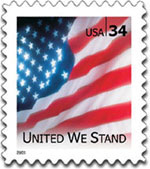 |
It was the regular,
monthly meeting of the Board of Governors at the Postal Service’s Washington,
D.C. headquarters. Through the windows, some who were attending the meeting
saw a brilliant orange flash and dark smoke across the Potomac River.
It was September 11. A jetliner hijacked by terrorists had just struck
the Pentagon, following similar attacks on New York’s World Trade Center.
Our nation was at war.
Through the anxious days that followed, the Postal Service continued to
do what it does best — deliver the mail. The appearance of letter carriers
making their rounds in virtually every community, both on the day of the
attacks and over the next week, helped to reassure the nation that the
fabric of everyday life, although damaged, was intact. That damage included our Church Street Station, located in the shadow
of New York’s Twin Towers. Our employees got out safely, and the Postal
Inspection Service secured the mail until delivery arrangements could
be made for customers in restricted areas of New York.
The temporary suspension of commercial airline traffic and new security
restrictions imposed by the Federal Aviation Administration resulted in
significant shifts of mail from air to surface transportation. Our new
alliance with FedEx was invaluable in keeping as much mail as possible
in the air. Despite the changes imposed on our operations, we continued
to serve the American people with high levels of performance.
Subsequent to the fiscal year, terrorists used the mail to attack representatives
of our government and the media. Tragically, two Postal Service employees,
Joseph Curseen Jr. and Thomas Morris Jr., were among five Americans who
died as a result of this assault on our freedom. The men and women of
the Postal Service found themselves on the front lines of a new kind of
war. They became quiet heroes simply by doing their jobs and keeping the
mail moving.
Meanwhile, we worked to keep the mail safe, through a nationwide campaign
of education, investigation, prevention and intervention. Every address
in America received a postcard with information about how to identify
— and what to do with — suspicious mail. The Postal Inspection Service,
working with the FBI and other law enforcement agencies, continued investigating
all leads. The Postal Service and the FBI offered a reward of $1 million
— augmented by an additional $250,000 from direct mailer ADVO — for information
leading to the arrest and conviction of those responsible. Personal protective
equipment and new operational procedures brought added levels of protection
to our employees. Finally, we purchased sanitization equipment and services
to eliminate biological hazards from some mail before it enters our processing
system. We are also exploring detection technologies.
For over 200 years, the mail has been a welcome and trusted daily presence
in every home and business in America. We are doing everything possible
to keep it that way.
|
 |
 |
...ONE NATION...
|
"It is
fitting that the U.S. Postal Service — which has served the people of
this nation since the dawn of our republic — will issue the United We
Stand postage stamp. For our primary mission has always been to bind the
nation together."
Robert Rider, Chairman,
United States Postal Service
Board of Governors.
|

















 continue...
continue...
